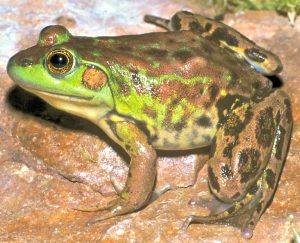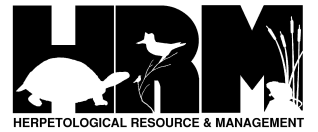Mink Frog
Overview:
Scientific Name: Rana septentrionalis
Size: 1.8 – 3” (adult length)
Status: Locally abundant in suitable areas.

Habitat:
Cool, permanent bodies of water with abundant emergent and floating plants. May inhabit slow streams, boggy lake inlets, and spring-fed ponds, especially where lily pads or other floating weedy vegetation is present.
Adult Coloration:
Back and sides may be green, olive, or brown, and patterned moderately to heavily with dark spots or blotches. Top of hind legs with rounded spots or vertical stripes. Upper lip green. Belly white, often blending to light yellow on sides and chin. Sometimes undersides entirely yellow..
Adult Characteristics:
Skin produces a musky odor when handled, similar to rotting onions. Dorsolateral folds poorly developed or absent, but are occasionally present. In males the tympanum (circular “ear” structure) is larger than the eye, and throat may be bright yellow. Females with tympanum smaller or equal to eye, and throats that are pale yellow or white. Voice: Series of soft, low-pitched croaks that may sound like distant hammering. e.g., http://www.youtube.com/watch?v=FOKE6qgyYn4
Larvae Characteristics:
Tadpoles may grow up to 4” in length before metamorphosis. Back is green, olive, or brown, usually with small dark spots or heavy mottling that can reach or extend onto the tail. Tail is long and pointed, and fins may have pinkish spots on the edges. Belly yellow-tinted and opaque.
Species Confused With:
Young bullfrogs may be similar, but are usually green and have sparse spotting. Green Frogs often have heavy patterning of dark spots where their range overlaps with the Mink Frog’s, but the two can be distinguished by the Mink Frog’s distinctive odor and the different patterns on the hindlegs: Mink Frogs have rounded spots or lengthwise bars while Green Frogs have dark crossbands.
References:
- Amphibians and Reptiles of the Great Lakes Region by Jim Harding
- Harding, J.H. and J.A. Holman. 1992. Michigan Frogs, Toads, and Salamanders. MSU Cooperative Extension Service and MSU Museum. Extension Bull. E-2350, 144 pp.
- Ruthven, A. G., H. B. T. Gaige, et al. 1912. The herpetology of Michigan, by Alexander B. Ruthven. Crystal Thompson and Helen Thompson; Memoranda towards a bibliography of the archaeology of Michigan, by Harlan I. Smith; prepared under the direction of Alexander G. Ruthven. Lansing, Mich., Wynkoop Hallenbeck Crawford, State Printers.
- Holman, J. A. 2012. The Amphibians and Reptiles of Michigan: A Quaternary and Recent Faunal Adventure. Detroit, Mich., Wayne State University Press.
- Conant, R., and Collins, J. T. 1998. Reptiles and Amphibians: Eastern, Central North America. Houghton Mifflin Harcourt Press.
